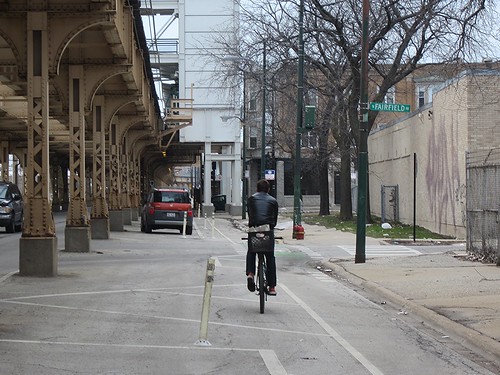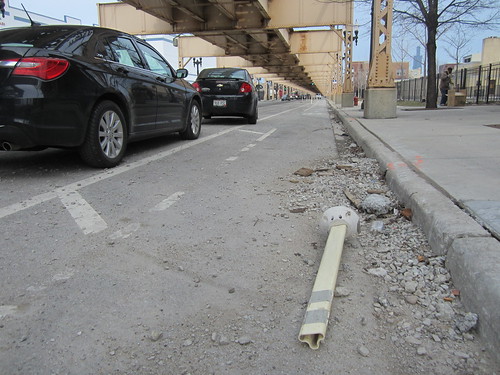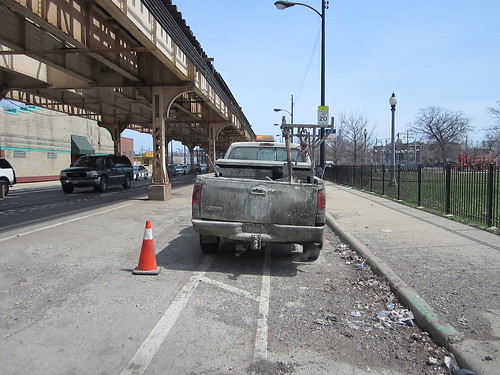Although I currently live a stone’s throw from Lake Street's protected bike lanes, I almost never ride in them. I moved to East Garfield Park during this snowy winter, when the PBLs rarely seemed to get plowed. Now that it’s springtime, the lanes are often filled with broken glass and garbage, and many of the flexible posts that separated them from the parking lane are lying on the sidewalk or in the bikeway. As a result, I almost always take Fulton, Warren/Washington, or Jackson to get downtown – anything but Lake.
Granted, I was skeptical in 2012, when the city installed PBLs on a two-mile stretch of Lake between Damen and Central Park. Lake is designated as a bike-priority Spoke Route in the Streets for Cycling Plan 2020, but I felt that Washington/Warren would be a more logical choice for the main bike route from the West Side to the Loop. It already has conventional bike lanes for much of its length, and it's already a popular route with commuters from West Side neighborhoods and suburbs like Oak Park. Meanwhile, Lake Street runs underneath the Green Lane tracks, which means there’s less sunlight, the ‘L’ pillars block sight lines at intersections, and there’s deafening noise from the occasional train overhead.
After the Chicago Department of Transportation recently announced plans to extend the PBLs three miles west to Austin Boulevard, members of a Yahoo group for West Side commuters told me they weren’t sure that it makes sense to do so. “Unless they maintain it, which [isn’t the case] from Central Park to Kedzie... they shouldn't waste the money,” wrote Oak Park resident Bill Watson.
Active Transportation Alliance director Ron Burke, also an Oak Parker and member of the Yahoo group, was sympathetic, writing the members:
Lake Street is perhaps the most challenging street with a protected bike lane, because of ongoing glass deposition, relatively little bike traffic to reinforce the bike lane's presence, and especially bad motorists behavior, with drivers knocking down posts, parking in the lane, etc. This past winter was the most challenging for snow and ice removal in a generation, so that amplified problems.
I agree the Lake Street bike lane is not very useable as is and have told CDOT that. The lane is going to be built in large part as a traffic-calming strategy. It will take away lanes that cars currently use for speeding and weaving, and that is needed badly. The street will be repaved, and that will help with potholes and standing water. The lane will extend to Austin, and that will make it more conspicuous and hopefully lead to better driver behavior. Then, hopefully we can get it swept and plowed better, posts replaced when knocked down, or a more durable physical separation barrier, and tickets for cars in the lane.
When I talked to Burke on the phone, he underscored that CDOT views the Lake Street PBLs as a traffic-calming project, which he endorses. Traffic calming is a beautiful thing, but is installing protected lanes on Lake, instead of along a more bike-friendly route like Washington/Warren, a sensible way to do it?
Burke noted that while the latter route has plenty of excess road width, it would be more politically challenging to install PBLs there, because those streets pass by many more residences and businesses. Lake also has the advantage of being two-way, while Washington and Warren are a couplet of one-ways. CDOT is looking into upgrading those streets to buffered lanes, he said. “I think Lake is could be a really good facility and could be well used, but it has to be well designed and well maintained,” Burke said.
CDOT spokesman Pete Scales told me that Lake will be better maintained in the near future. “We have not yet been out to sweep the Lake street protected bike lanes this spring, as we are in the process of acquiring a sweeper that is the appropriate size to fit in those PBLs,” he said. “We will be out to address the debris as soon as the proper equipment becomes available.”
Scales said there actually has been plenty of support from bicyclists for building PBLs on Lake. “We heard from cyclists during the Streets for Cycling Plan 2020 meetings that Lake was the preferred route due to many factors, including the direct shot to and from downtown and the connectivity with the CTA's Green Line,” he said.
What’s your opinion – assuming the lanes can be better maintained, does it make sense to extend the Lake Street PBLs?







